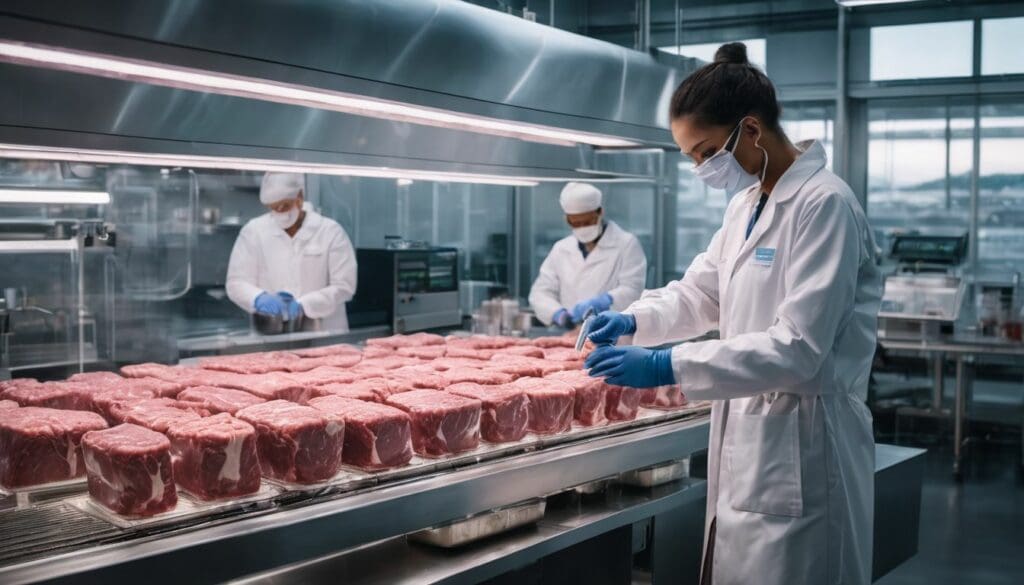As we sit down to our dinners, contemplating the juicy cuts and succulent bites, there’s an awareness that edges in – the recognition of the sheer environmental toll wrought by conventional meat production.
It’s a concern shared by many, a niggling guilt at the back of our minds as we savour each forkful. Resolute to find a solution, we’ve delved into alternatives and unearthed something quite remarkable: lab-grown meat could plummet greenhouse gas emissions by an impressive 96%.
Our feature unravels this intriguing culinary advancement with gusto; it’s not just food for thought but could very well redefine what lands on our plates in years to come. So stay with us – your gastronomic curiosity might just be kindled by an eco-friendly spark.
Key Takeaways
- Lab – grown meat could reduce greenhouse gas emissions by up to 96%, presenting a sustainable alternative that may cut land use by as much as 98%.
- Producing meat in labs has lower risks of contamination and disease compared to traditional methods, enhancing food safety for consumers.
- The development of lab – grown meat faces challenges like high energy consumption, production costs, and the need for proper regulatory frameworks.
- There are ethical issues to consider with lab-grown meat regarding the welfare of animals used for cell samples and the impact on farmers accustomed to traditional livestock practices.
- While lab-grown meat holds promise for sustainability, it’s important to look at its long-term environmental effects and ensure it can be a viable part of future food systems.
The Emergence of Lab-Grown Meat
Building on the quest for sustainable solutions within the meat industry, lab-grown meat has surfaced as a groundbreaking innovation. Scientists cultivate this meat directly from animal cells, creating a product that looks and tastes like traditional meat without raising and slaughtering animals.
Our awareness of its potential perks keeps growing, especially considering how it might revolutionise food production while caring for our planet.
This advancement catapults us into an era where ethical meat production aligns with environmental conservation efforts. Imagine slashing greenhouse gas emissions by up to 96% and cutting land use by 98%, as studies suggest.
We’re not just talking about minor tweaks in how we make our burgers; we’re witnessing a complete transformation of the paradigm, promising massive strides towards sustainability in what we eat and how it reaches our plates.
Benefits of Lab-Grown Meat
Lab-grown meat offers several benefits, including reduced greenhouse gas emissions and land and water use. It also provides increased food safety and addresses ethical considerations in the meat industry.
Reduced greenhouse gas emissions
Lab-grown meat production significantly reduces greenhouse gas emissions. Studies suggest that it could cut down these emissions by up to 96%, making it a promising solution for combating climate change.
The process of cultivating meat from animal cells requires far fewer resources and energy compared to traditional beef production, resulting in a substantially smaller carbon footprint.
This means that lab-grown meat has the potential to play a crucial role in curbing global greenhouse gas emissions and addressing environmental concerns associated with conventional livestock farming.
Furthermore, the remarkable reduction in greenhouse gas emissions accompanied by lab-grown meat production aligns with the increasing demand for sustainable and environmentally friendly food options.
Reduced land and water use
Lab-grown meat production significantly reduces land and water use, offering a more sustainable alternative to traditional livestock farming. Studies show that lab-grown meat could cut down land use by up to 98% and reduce water consumption in the meat industry.
This reduction would address the environmental impact of animal agriculture, making strides towards a more environmentally friendly and efficient food system.
Cultivated meat also has the potential to offer relief from the strain on natural resources caused by conventional meat production, contributing to a more sustainable and balanced approach to food security.
Increased food safety
Transitioning from reduced land and water use to increased food safety, it’s important to note that lab-grown meat offers enhanced food safety. As lab-grown meat is produced in a controlled environment, the risk of contamination with harmful bacteria such as E.
coli and salmonella is significantly reduced. This means that consumers can have greater confidence in the safety of lab-grown meat compared to traditional meat products. Additionally, since lab-grown meat does not involve animal rearing and slaughter, there is a lower risk of exposure to diseases associated with livestock farming.
These factors contribute to an overall improvement in public health and food security, making lab-grown meat an appealing alternative for those concerned about the safety of their food.
Ethical considerations
After weighing the health and environmental benefits of lab-grown meat, it’s important to delve into the ethical considerations. Although this sustainable alternative could potentially reduce animal suffering by eliminating the need for traditional livestock farming, there are concerns about the welfare of animals from which cell samples are obtained.
The process of obtaining these samples must be conducted in an ethical manner to ensure that animals are not subjected to unnecessary harm or distress.
Additionally, issues surrounding consent and patenting of animal cells also come into play. As this emerging technology advances, questions arise about ownership and intellectual property rights related to cultured meat.
Controversies and Drawbacks
One of the main controversies surrounding lab-grown meat is its high energy consumption and production costs, which could hinder its widespread adoption. Additionally, there is a lack of a regulatory framework to ensure the safety and quality of lab-grown meat products, raising concerns about public health.
High energy consumption and costs
Lab-grown meat production demands a substantial amount of energy, primarily due to the need for regulated and sterile lab conditions. The energy-intensive process involves maintaining optimal temperatures, humidity levels, and lighting in controlled laboratory environments.
Additionally, the costs associated with the research, development, and production of lab-grown meat are considerably high. Investment in specialised equipment and resources are necessary to ensure that the end product meets safety standards and is nutritionally sound.
As we delve into the controversies surrounding lab-grown meat, it’s also crucial to consider its potential impact on both traditional farmers and the wider meat industry. This paradigm shift has sparked debates about sustainability beyond environmental metrics; it requires an assessment of economic viability as well.
Lack of regulatory framework
As of now, there is a lack of regulatory framework governing the production and consumption of lab-grown meat. This absence has raised concerns about labelling standards, safety protocols, and sustainable practices within the industry.
The introduction of comprehensive regulations will be crucial to ensure that lab-grown meat meets strict health and environmental standards, fostering trust among consumers and facilitating its integration into the mainstream market.
To address these issues, policymakers need to engage with scientific experts and stakeholders to establish transparent guidelines for the development, production, and commercialisation of lab-grown meat.
Potential impact on traditional meat industry
While the lack of regulatory framework has been a concern in the development of lab-grown meat, there is also much discussion around its potential impact on the traditional meat industry.
With lab-grown meat production gaining traction, it could potentially disrupt traditional farming practices and the entire meat industry. Traditional farmers may face significant challenges as consumers shift towards sustainable and environmentally friendly alternatives like lab-grown meat.
This shift could lead to changes in consumer preferences, market demand, and ultimately affect the livelihoods of those involved in traditional meat production.
The emergence of lab-grown meat has raised concerns about its potential to replace conventional animal agriculture and impact existing supply chains. The increased awareness about environmental sustainability may drive consumers to opt for alternative protein sources, causing a decline in demand for traditionally farmed meats.
Is Lab-Grown Meat Truly Sustainable?
When comparing the carbon footprint and resource usage of lab-grown meat to traditional meat, it is important to consider the long-term sustainability of this new technology. The environmental impact and overall sustainability of lab-grown meat are vital considerations for the future of food production.
Carbon footprint comparison
In examining the carbon footprint of lab-grown meat versus traditional meat production, we find ourselves looking at a complex picture. Here’s a straightforward comparison in table format to provide a clear overview of the differences:
table {
font-family: Arial, sans-serif;
border-collapse: collapse;
width: 100%;
}
td, th {
border: 1px solid #dddddd;
text-align: left;
padding: 8px;
}
Carbon Footprint Comparison: Lab-Grown Meat vs Traditional Meat
| Aspect | Lab-Grown Meat | Traditional Meat |
|---|---|---|
| Greenhouse Gas Emissions | Potentially up to 96% lower emissions | Significant contributor to global emissions |
| Land Use | Up to 98% reduction in land use | Requires large tracts of land for grazing and feed |
| Water Use | Significantly lower water consumption | High water usage for animal upkeep and feed production |
| Long-Term CO2 Concentrations | Could generate higher concentrations of CO2 over time | Emissions include methane, which has a higher warming potential in the short term |
| Energy Consumption | High energy requirements depending on the technology used | Varies, but overall less energy-intensive than lab-grown methods currently |
We see that lab-grown meat offers a marked improvement in several environmental areas, including greenhouse gas emissions and land use. However, we must also consider that lab-grown meat production could lead to higher concentrations of CO2 over time. Our quest for sustainability in food production continues to challenge us, and we’re committed to exploring every avenue that might lead to a more environmentally friendly future.
Resource usage comparison
Lab-grown meat production is estimated to use 99% less land than traditional beef farming. Additionally, it has the potential to reduce water usage by 90%. According to studies, lab-grown meat could result in a significant reduction in resource consumption compared to conventional meat production methods. These findings suggest that lab-grown meat holds promise as a sustainable and environmentally friendly alternative for meeting the growing demand for protein.
Moving on to – Carbon footprint comparison…
Conclusion and Future of Lab-Grown Meat
In conclusion, lab-grown meat offers promising potential as a sustainable solution to the meat industry. It has the capacity to reduce greenhouse gas emissions significantly and diminish land and water use.
Moreover, this innovation could bring about positive health impacts and ethical considerations. As more research is conducted and technology advances, the future of lab-grown meat seems bright and may revolutionise the food industry.
FAQs
1. What is lab-grown meat?
Lab-grown meat, also known as in vitro or clean meat, is made from animal cells grown in a lab setting instead of taken from live animals.
2. How does producing synthetic meat help the environment?
Producing synthetic meat has less environmental impact than traditional farming; it requires less land and can be more environmentally friendly by reducing greenhouse gas emissions.
3. Are there health benefits to eating lab-grown over conventional meat?
Yes, since lab-grown or clean meat can be controlled during production, it may reduce the risk of contamination and disease found in traditionally farmed meats.
4. Could switching to invitro meat improve sustainability in the food industry?
Switching to invitro or sustainable meat could lead to a significant reduction in resources needed for livestock farming, potentially creating a more sustainable food future.
5. Is growing synthetic meat better for land use than raising livestock?
Yes indeed! The technology behind sustainable or cultured meats means potentially using much less land compared to conventional livestock rearing methods, leading towards a more efficient land use system.





